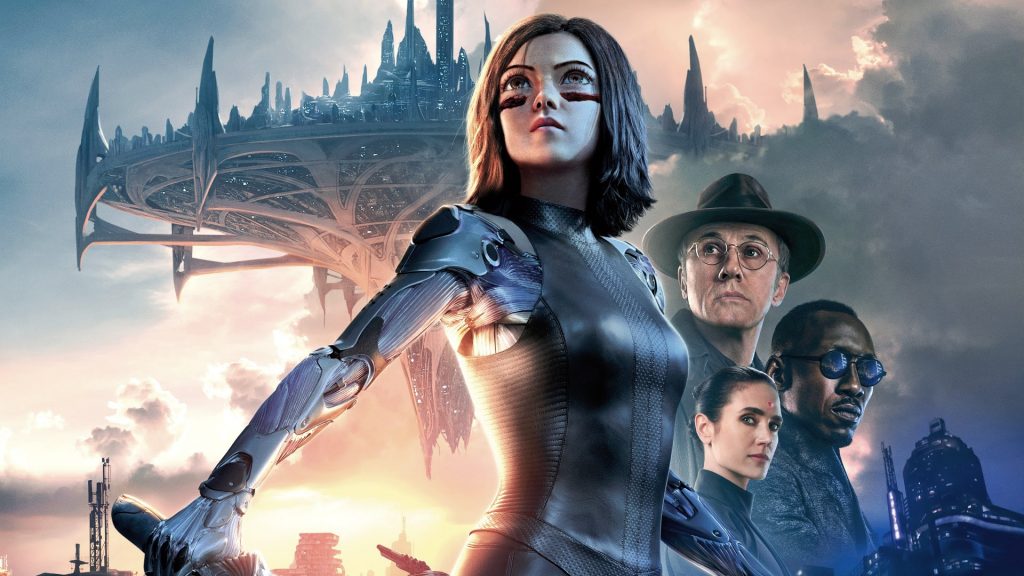Alita: Battle Angel feels like a breath of fresh air, chock full of breathtaking world building and gorgeous action, threaded through a dense plot that threatens to break apart at the seams during the film’s 122 minutes runtime.
It doesn’t get everything right, but it’s a remarkable achievement in cinematic storytelling, and for once, I am looking forward to a sequel for a non-Marvel property.
Uncovering Alita’s Past
In 2563, some 300 years after a catastrophic event called the Fall that ended a war between Earth and the URM (United Republic of Mars), Dr. Ido (Christoph Waltz) discovers the core of a female cyborg in a trash heap. He rebuilds her, using parts he had built for his own daughter, and renames her Alita after said daughter.
Alita’s uncanny valley-esque appearance, with her large anime eyes and cartoony smile, is unnerving at first, but her humanity (and adorable personality) soon wins you over.
It takes little time for Alita to endear herself to the audience, as she revels in delight when she tastes chocolate for the first time and participates with other street kids in the popular sport, motorball. She lives in Iron City, which is filled with squalor and overshadowed by the floating city of Zalem, where the rich and elite dwell.
As Alita slowly regains her memories and finds love in the form of a teenager named Hugo, she gets drawn into conflict with shady forces, often cyborgs, the chief of them is the hulking brute named Grewishka. He answers to the enigmatic Nova, who can talk control of anyone with a neural implant and rarely shows his face.
Impressive World Building and Solid Acting Elevate the Film
The world building in this film is striking, as it presents a world that feels lived in, with a lot of backstory that can be explored throughout later entries. The action is also gorgeous, striking in a manner that hasn’t been seen since 2013’s Pacific Rim. It’s kinetic, dynamic and shot in a manner that hearkens the urgency of the recent Deus Ex games, which fit well into the film’s anime and Blade Runner aesthetics.
Directed by Robert Rodriguez, who usually sticks to low budget, stylish flicks such as From Dusk till Dawn and Desperado, the film is also produced by James Cameron, who also does double duty on the script with Rodriguez and Laeta Kalogridis. The film may finally break the curse of poorly received anime adaptations, following the heels of 2017’s Ghost in the Shell.
Rosa Salazar does an impressive job as Alita, whose character is strongly portrayed and is the heart of the film. Christoph Waltz also does well as the concerned parent Ido, although he is often burdened with exposition and he doesn’t get as much room to stretch his chops as an actor of Waltz’s caliber could. Still, there is an unexpected delight in watching Waltz swing around an oversized hammer.
What Doesn’t Work
The film’s weak point is the romance sub plot, although an argument could be made that the hokey nature of the romance reflects the fact that both parties involved are teenagers (although Alita is, technically, over 300 years old). It grinds the film almost to a halt near the three-fourths mark of the film, and although it ends on a poignant note, one can’t help but feel if the story wouldn’t have been better serviced by giving more focus to the action and world building.
The runtime also feels a tad too long, and the plot is filled with lots of developments, adapting the first four volumes of the manga, created by Yukito Kushiro in the 1980s. The film ends on an obvious sequel hook, but with a world this rich and a strong protagonist, there is certainly a lot of room to explore.
The Verdict
Alita: Battle Angel isn’t as thematically rich as it could be, unlike its source material. There’s ample room to discuss the meaning of being human, and while the topic is lightly touched, there’s a lot more that could be explored. This is something that Ghost in the Shell does a bit better, and it pains me to say that film is better than Alita: Battle Angel in any aspect.
However, not every cyberpunk story needs to be heavy and dwell on the human condition, and for now, what’s already there is enough to keep me coming back for more.
